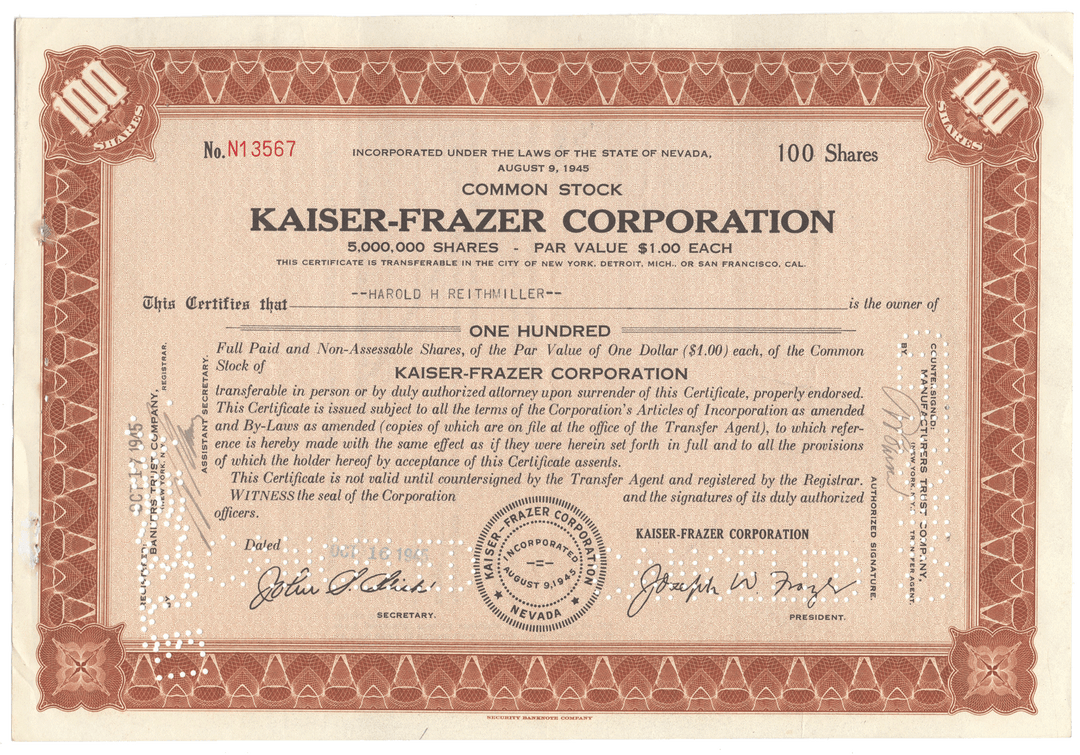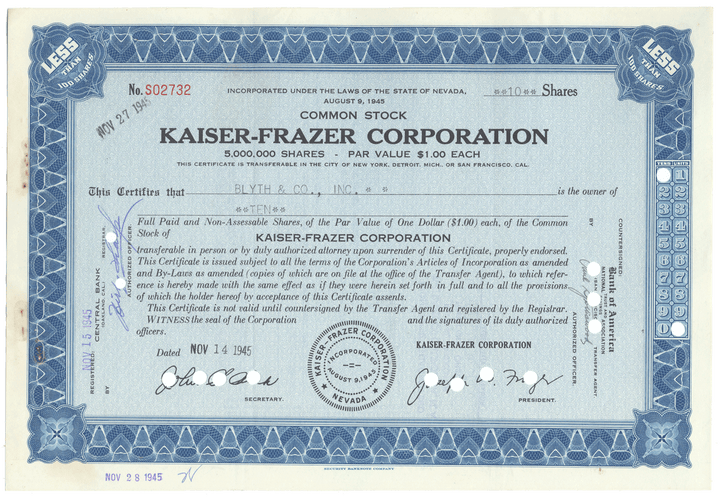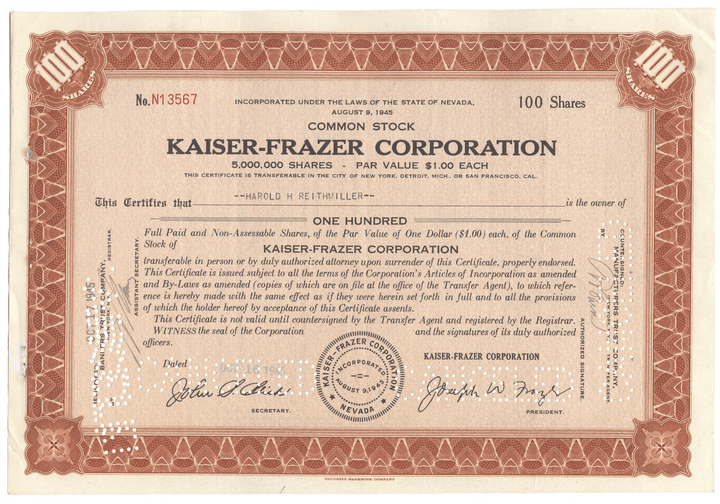Kaiser-Frazer Corporation
- Guaranteed authentic document
- Orders over $75 ship FREE to U. S. addresses
Images are representative of the piece you will receive
Over 75 years old
Common stock
1940's
Issued, canceled
Security Bank Note Company
Machine printed signatures
12" (w) by 8" (h)
NA
Historical Context

The Kaiser-Frazer Corporation was established in August 1945 as a joint venture between the Henry J. Kaiser Company and Graham-Paige Motors Corporation. Both Henry J. Kaiser, a California-based industrialist and Joseph W. Frazer, CEO of Graham-Paige, wanted to get into the automobile business and pooled their resources and talents to do so. Less than a year after Kaiser-Frazer's formation, the first Kaiser and Frazer branded automobiles were being produced at the Willow Run, Michigan, headquarters for both Kaiser-Frazer and Graham-Paige. By the end of 1946, over 11,000 cars (total Kaiser and Frazer) were shipped to dealers and distributors, many of which sold to end users. During the summer of 1948, the 300,000th car came off the production line.
In 1950, Kaiser-Frazer began production of a new compact car, the Henry J and ended production of the Frazer automobile. Both makes were 1951 model year automobiles. In 1952 and 1953, Kaiser-Frazer provided Sears, Roebuck and Company with Allstate-branded automobiles that retailer sold through selected Sears Auto Centers. The cars, based on the Henry J models that Kaiser-Frazer dealers were selling, were in the Sears catalog, but the car could not be purchased by mail order.
At the 1953 New York Auto Show, Kaiser-Frazer announced it would produce a fiberglass bodied sports car, called the Kaiser-Darrin-Frazer 161 The car had a 161 cubic inch six-cylinder engine and was designed by stylist Howard "Dutch" Darrin, who also did the 1947–48 Kaiser & Frazer as well as the 1951 Kaiser automobiles. The vehicle went into production during January 1954 and was sold as the Kaiser Darrin. Production of the Allstate ended during 1953, the last Henry J automobiles were built in late 1953 as 1954 model year cars. The sports car was in production only during the 1954 model year.
While sales were initially strong because of a car-starved public, the company did not have the resources to survive long-term competition with the "Big Three" automakers. The original Kaiser-Frazer design was distinctive and fresh but the company was unable to maintain the price point needed for long-term success. However, the company's problems started as early as 1948. That year, Joseph Frazer resigned as president of Kaiser-Frazer, but stayed in the position as a "lame duck" until April 1949 when Henry J. Kaiser's oldest son, Edgar, took Frazer's place as president. This was in part because Frazer had warned Kaiser not to tool up for 200,000 cars for the 1949 model year, realizing that they could not compete against the new cars from the big three coming out that year. Unfortunately, Kaiser did not heed the warning, saying "The Kaisers never retrench." Only 58,000 cars were sold that year. The Frazer marque was discontinued after the 1951 models. Joseph Frazer remained as a sales consultant and vice-chairman of the Kaiser-Frazer board until 1953.
At the 1953 annual stockholders' meeting, Kaiser-Frazer Corporation's name was changed by stockholder vote to Kaiser Motors Corporation. Shortly before meeting, Kaiser-Frazer's Kaiser Manufacturing Corporation division worked out a deal to purchase certain assets (and assume certain liabilities) of the Willys-Overland Corporation, makers of Willys cars and Jeep vehicles. After completing the acquisition, Kaiser Manufacturing Corporation changed its name to Willys Motors, Incorporated. During late 1953 and 1954, Kaiser Motors operations at Willow Run Michigan were closed down or moved to the Willys facility in Toledo, Ohio.
Kaiser-Frazer was able to work out deals with General Motors to purchase GM Hydramatic automatic transmissions, and also detuned Rocket 88 engines from Oldsmobile with deliveries starting in the 1952 model year. The deal was contingent on Olds expanding its Lansing, MI, engine production facility but that expansion was cancelled due to military needs for the Korean War. K-F had their own V8 engine development program that ran through 1949 but, as the lead engineers on the team stated to the Society of Automotive Engineers (SAE) they found their work was leading down a "blind alley" and would not succeed. Frazer cars ended up suffering as a luxury and upper medium priced models due to changing market conditions, just as Hudson and Studebaker experienced during the 1950s. The Henry J, while a reasonable idea, was restricted by the terms of a re-capitalization loan the government made to the company in the fall of 1949. Kaiser-Frazer labor agreements resulted in the company paying the highest wages of any American automaker while having a productivity rate of only 60–65% in return. Kaiser tried to resolve its deficiencies with schemes like elaborate designer interiors with fancy dashboards and upholstery. A line of "Traveler" sedans with the trunk connected to the interior of the car were an improvised attempt at marketing a model to compete with standard station wagon designs.
The last Kaisers were produced in America during the 1955 model year. Close to 760,000 cars were produced of all makes and models between May 1946 and September 1955. At the end of 1955, the management team of the Henry J. Kaiser Company used Kaiser Motors Corporation to create a new holding company encompassing the various Kaiser industrial activities. Kaiser Motors' name was changed to Kaiser Industries Corporation, and functioned as a holding company for various Kaiser business holdings including Willys Motors Incorporated.
While U.S. production of Kaiser and Willys passenger cars ceased in 1955, production of Willys Jeeps in Toledo, Ohio, continued. Kaiser continued automobile production in Argentina under the Industrias Kaiser Argentina (IKA) company established in Santa Isabel, Córdoba and Willys passenger cars moved to Brazil under the Willys-Overland do Brasil company, using the U.S. dies, well into the 1960s.
The company changed its name to Kaiser Jeep in 1963. By 1969, Kaiser Industries decided to leave the auto business, which was sold to American Motors Corporation (AMC) in 1970. As part of the transaction, Kaiser acquired a 22% interest in AMC, which it later divested. Included in the sale was the General Products Division, which Kaiser had purchased from Studebaker in 1964 as Studebaker prepared to leave the auto business. AMC renamed the division AM General, which still operates today, and is best known as the manufacturer of the Humvee and civilian Hummer H1.r the control of Henry J. Kaiser himself and some were not.
Related Collections
Additional Information
Certificates carry no value on any of today's financial indexes and no transfer of ownership is implied. All items offered are collectible in nature only. So, you can frame them, but you can't cash them in!
All of our pieces are original - we do not sell reproductions. If you ever find out that one of our pieces is not authentic, you may return it for a full refund of the purchase price and any associated shipping charges.









